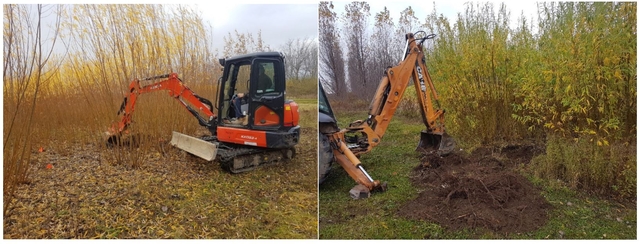A long-term study conducted at the University of Guelph, Ontario, Canada focused on Carbon (C) sequestration through bioenergy cropping systems in non-agricultural lands (Figure 1) (Bazrgar et al. 2020). These systems sequester atmospheric CO2 in their fibre, as well as in the soil through residue inputs (litterfall, coarse root and fine-root turnover, soil microbial processes, etc. Figures 2 and 3) (Coleman, et al. 2018). In Canada, the current estimate of non-agricultural (marginal) land area that can be brought under biomass crop production is 9.5 million ha (Ashiq et al. 2017). Meanwhile, a significant increase in bioenergy production has also been predicted based on global future energy scenarios. Understanding the system-level C storage potentials in woody and herbaceous cropping systems (long term soil organic carbon (SOC) sequestration, belowground biomass C, annual litter input and fine root turnover associated C), and how these system-level C dynamics will change as systems mature will help biomass growers to comprehend long-term C sinks influenced by biomass crops.
The University of Guelph established its long-term biomass research infrastructure in 2009 (Figures 1 and 4) to study the long-term C gain potentials at the system-level in woody (poplar and willow), and herbaceous (miscanthus and switchgrass) bioenergy crop production systems on marginal lands in Sothern Ontario, Canada, and their future contribution to climate change mitigation efforts. For this purpose, above- and belowground biomass and soil C sequestration in woody and herbaceous systems were quantitatively assessed at the end of 2017 and 2018 growing seasons (late fall) by destructive sampling technique. SOC data obtained from 2017 and 2018 were then compared with the baseline 2009 SOC values to determine SOC gain or loss over the nine years since the establishment of the biomass test plots (Figure 4). Bulk density samples were also obtained for each cropping system (willow, poplar, switchgrass, and miscanthus) at 0–15 cm and 15–30 cm depths in 2009 and 2018 to allow carbon stocks to be calculated for each depth (Graham et al. 2019). Woody cropping systems had significantly higher aboveground biomass C stock of 10.02 compared to 7.65 Mg C ha−1 in herbaceous biomass system. However, there was no significant difference in the belowground biomass C values. Poplar and willow (woody crops) and switchgrass (herbaceous) were able to increase SOC significantly over the nine-year period. However, the gain in SOC in the nine years (∆SOC) was not significantly different between woody and herbaceous biomass crops; 11.0 and 9.8 Mg C ha−1, respectively. Results also indicated significantly higher total C pool [aboveground + belowground + soil organic carbon] in the willow (103 Mg ha−1) biomass system compared to other bioenergy crops. At the systems level, over a period of nine years, woody crops had only 1.35 Mg C ha−1 more than the herbaceous biomass systems, suggesting that the influence of woody and herbaceous biomass crops at the system level carbon gain were similar. This study only looked at carbon sequestration by both biomass systems over a period of nine years. Therefore, there is a need to continue to study these systems over the next 10 years in order to fully understand the carbon sequestration potentials by these biomass systems. In addition to carbon sequestration, ease of adoption (conversion of low productive agricultural lands to biomass cropping systems), market demand (quality of biomass for specific end-use), and other uses of biomass (animal feed, bedding etc.) can also influence the growers to decide on what type of biomass to grow.
 Figure 1. Guelph Agroforestry Research Site, University of Guelph, Guelph, Ontario, Canada, in 2006 (top), 2009 (center) and 2018 (bottom). HBCS (Herbaceous biomass cropping system), WBCS (Woody biomass cropping system), and AgF (Conventional agricultural field) (Google Earth Pro, 2019; Bazrgar et al., 2020).
Figure 1. Guelph Agroforestry Research Site, University of Guelph, Guelph, Ontario, Canada, in 2006 (top), 2009 (center) and 2018 (bottom). HBCS (Herbaceous biomass cropping system), WBCS (Woody biomass cropping system), and AgF (Conventional agricultural field) (Google Earth Pro, 2019; Bazrgar et al., 2020).
 Figure 2. Destructive sampling of short-rotation willow belowground biomass (roots) in Guelph, Ontario, Canada, University of Guelph Research Station (2018)
Figure 2. Destructive sampling of short-rotation willow belowground biomass (roots) in Guelph, Ontario, Canada, University of Guelph Research Station (2018)
![Figure 3. Willow (left) and switchgrass (right) cropping system in Guelph, Ontario, Canada [University of Guelph Research Station (2018)].](/images/Summer_2020_figs/Fig_3_1.jpg) Figure 3. Willow (left) and switchgrass (right) cropping system in Guelph, Ontario, Canada [University of Guelph Research Station (2018)].
Figure 3. Willow (left) and switchgrass (right) cropping system in Guelph, Ontario, Canada [University of Guelph Research Station (2018)].
![Figure 4. Aerial picture (by drone) showing the long-term biomass research site in Guelph, Ontario, Canada [University of Guelph Research Station (2018)].](/images/Summer_2020_figs/Fig_4.JPG)
Reference
- Ashiq MW, Bazrgar AB, Fei H, Coleman B, Vessey K, Gordon A, Sidders D, Keddy T, Thevathasan NA (2017) Nutrient-based sustainability assessment of purpose-grown poplar and switchgrass biomass production systems established on marginal lands in Canada. Can. J. Plant Sci., 98, 255–266.
- Bazrgar AB, Ng A, Coleman B, Ashiq MW, Gordon A, Thevathasan N (2020) Long-term monitoring of soil carbon sequestration in woody and herbaceous bioenergy crop production systems on marginal lands in Southern Ontario, Canada, Sustainability,12(9), 3901; https://doi.org/10.3390/su12093901
- Coleman B, Bruce K, Chang Q, Frey L, Guo S, Tarannum MS, Bazrgar A, Sidders D, Keddy T, Gordon A, (2018) Quantifying C stocks in high-yield, short-rotation woody crop production systems for forest and bioenergy values and CO2emission reduction. For. Chron., 94, 260–268.
- Graham J, Voroney P, Coleman B, Deen B, Gordon A, Thimmanagari M, Thevathasan N (2019) Quantifying soil organic carbon stocks in herbaceous biomass crops grown in Ontario, Canada. Agrofor. Syst., 93, 1627–1635.
